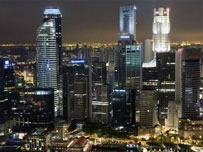
From the putrid, ever-expanding slums in megalopolises such as
From the putrid, ever-expanding slums in megalopolises such as
 Air pollution, already above World Health Organization standards in most cities, is worsening as car ownership surges, while factories required to drive unprecedented economic growth pump increasing amounts of waste into waterways.
Air pollution, already above World Health Organization standards in most cities, is worsening as car ownership surges, while factories required to drive unprecedented economic growth pump increasing amounts of waste into waterways.
Meanwhile, the carbon and resource footprints of Asian cities are ballooning as hundreds of millions of people grow richer, consume more and depend largely on fossil-fuel driven economies to drive wealth creation.
Nevertheless, urban planners and green activists point to many environmental success stories throughout
"Many big picture trends in regards to the environment are getting worse but I also see the trends that are offering solutions," said Red Constantino, head of the Manila-based Institute for Climate and
"Those (positive) trends are picking up steam. And you have to start somewhere. So I don't think doom and gloom scenarios are very helpful right now. It doesn't factor in the positive drivers that are out there."
Constantino cited the stunning expansion of
Professor Yeung Yue-man, emeritus professor of geography at the
"It doesn't look bad for cities in Asia," said Yeung, who is also an adviser to the
"In terms of what is needed for infrastructure and looking after their people, in many Asian cities, especially ones that are better off economically, they have embraced the concept of sustainable development."
Yeung said
A report by the Economist Intelligence Unit released in February assessing the green credentials of 22 major cities in
China's world-leading ambitions for renewable energy were praised, specifically the nation's biggest off-shore wind farms near Shanghai that are expected to provide electricity for four million households by 2020.
On a more showcase level, it pointed to the 71-storey
The Economist Intelligence Unit's Asian Green City Index report also highlighted the
Under the scheme, the Japanese capital is aiming to cut its emissions of carbon dioxide and other gases blamed for global warming by 25 percent by 2020 from 2000 levels, as well as spur similar measures by the national government.
Meanwhile, in
Three liters of water out of every 100 that Singaporeans drink now comes from wastewater that has been filtered and purified.
Nevertheless, the scale of environmental damage caused by fast-expanding cities cannot be glossed over, the Asian Development Bank warned in a major report on Asian urbanization.
It said the economic, health and other costs of environmental degradation were more than $2 billion a year in
"Costs in
And while recognising many positive trends, the ADB also emphasized that more needed to be done to convince authorities that caring for the environment would benefit their economies.
"City administrators need to believe in sustainable growth and reject the notion that they must choose between protecting the environment and promoting prosperity," the report said.
"There is a direct connection between environmental protection and wealth creation."

 Previous page
Previous page Back to top
Back to top







